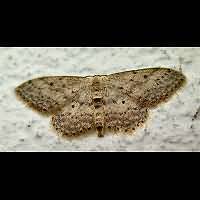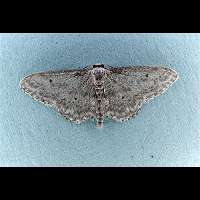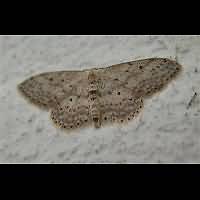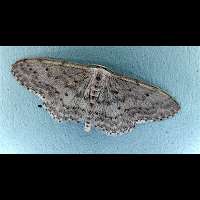Small Dusty Wave (Idaea seriata)
The Small Dusty Wave is small indeed and also very indistinctly marked. So it is a good thing we have pictures on this page. The ground colour is light grey to light brown. It is dusty all over and there is a clear dot in what seems to be the middle of the wing. Luckily there is no other wave similar to this one, so identification shouldn't be too difficult. You might mix it up with one of the pugs though. But there is no pug as dusty as this, so no big problem there either. Sometimes a very dark form is seen. This black form, which is quite rare, is called f. bischoffaria. The wingspan is just around 2 cm.
This species is double-brooded, except for the north. The two generations usually overlap one another. The larva of the summergeneration overwinters. It needs quite some time to be fullgrown. The larvae of the springgeneration on the other hand often take less than 5 weeks to complete their development. The caterpillar will reach a length of about 18 mm. It is brown with black markings on the first segments behind the head. It pupates in a little hole in the ground, where it makes a cocoon. The larvae are found on ivy and dandelions mainly.
Where two generations appear the animal is on the wing from May to October. The greatest number of specimens flies in August, though. In Scotland and further northwards there is only one generation on the wing in July or August. In southern parts of Europe there are even more generations resulting in the species being seen all year round. The adults are often noticed on walls and fences during day time. Does not fly till well after dark and is rarely attracted to artificial lights. Lives in gardens, hedgerows and rough territories, often near human habitation. Common all over Britain, including Scotland. Common and sometimes abundant all over Europe, Northern Asia and Siberia.
The Small Dusty Wave is small indeed and also very indistinctly marked. So it is a good thing we have pictures on this page. The ground colour is light grey to light brown. It is dusty all over and there is a clear dot in what seems to be the middle of the wing. Luckily there is no other wave similar to this one, so identification shouldn't be too difficult. You might mix it up with one of the pugs though. But there is no pug as dusty as this, so no big problem there either. Sometimes a very dark form is seen. This black form, which is quite rare, is called f. bischoffaria. The wingspan is just around 2 cm.
This species is double-brooded, except for the north. The two generations usually overlap one another. The larva of the summergeneration overwinters. It needs quite some time to be fullgrown. The larvae of the springgeneration on the other hand often take less than 5 weeks to complete their development. The caterpillar will reach a length of about 18 mm. It is brown with black markings on the first segments behind the head. It pupates in a little hole in the ground, where it makes a cocoon. The larvae are found on ivy and dandelions mainly.
Where two generations appear the animal is on the wing from May to October. The greatest number of specimens flies in August, though. In Scotland and further northwards there is only one generation on the wing in July or August. In southern parts of Europe there are even more generations resulting in the species being seen all year round. The adults are often noticed on walls and fences during day time. Does not fly till well after dark and is rarely attracted to artificial lights. Lives in gardens, hedgerows and rough territories, often near human habitation. Common all over Britain, including Scotland. Common and sometimes abundant all over Europe, Northern Asia and Siberia.







